Approaching the Past - Toronto
A Series Connecting People Teaching History
Approaching the Past is a workshop series in Toronto, Vancouver, and Fredericton organized by THEN/HiER. The goal of the series is to create and strengthen ties between history educators working in a variety of contexts, including middle and high schools, universities (both faculty and graduate students), and museums. Workshops offer the opportunity to connect with colleagues, meet people teaching history in unique and engaging ways, and be challenged to teach history in ways that connect more deeply with our students.
Contact Anne Marie Goodfellow for more information.
Approaching the Past 2013/14
The theme of this year's series was "Investigating Toronto's Histories." See the poster.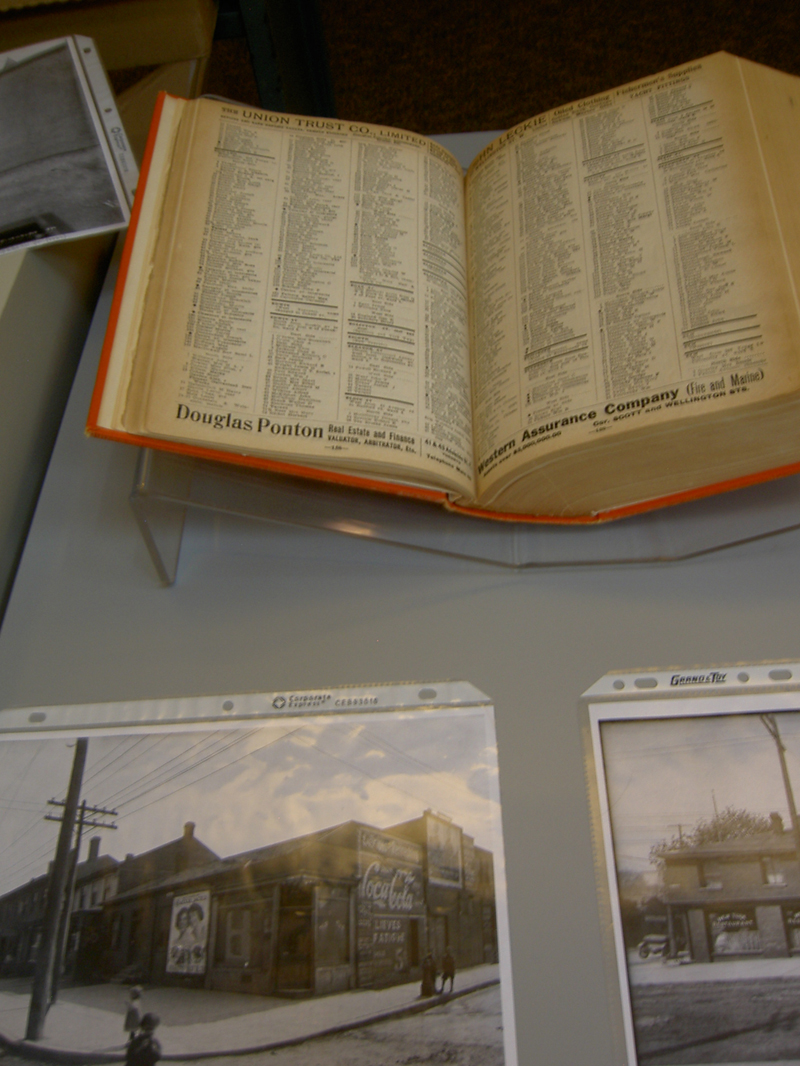
The first Approaching the Past event, Picturing Toronto On and Off the Grid, was held on October 2 at the City of Toronto Archives. The exhibition on display was “Toronto on the Grid” which included 100 years of street photography. Participants, mostly teachers and teacher candidates, were introduced to using primary documents such as photos in their classrooms. Thanks to Gillian Reddyhoff of the Toronto Archives. Stewart Boden of the Ontario Archives did a presentation titled “Lights Camera Archives” and gave CDs of the historical footage from his presentation to all participants.
 The second event took place on November 5 at Colborne Lodge in High Park. Exploring Landscapes of Leisure began with a tour of historic Colborne Lodge (a historical museum built in 1836 by John George Howard, an architect and engineer), and was followed by two talks. The first talk by museum educator Catherine Raven provided insight into the history and geography of the land and environment of the park. Her presentation included beautiful images of the park, the historic house, and the Toronto Waterfront. For the second talk, Toronto teacher Katy Whitfield showed photographic evidence of the diverse uses of the park's land as an important historic space, and distributed a special package of materials she created for participants that incorporated historical thinking concepts.
The second event took place on November 5 at Colborne Lodge in High Park. Exploring Landscapes of Leisure began with a tour of historic Colborne Lodge (a historical museum built in 1836 by John George Howard, an architect and engineer), and was followed by two talks. The first talk by museum educator Catherine Raven provided insight into the history and geography of the land and environment of the park. Her presentation included beautiful images of the park, the historic house, and the Toronto Waterfront. For the second talk, Toronto teacher Katy Whitfield showed photographic evidence of the diverse uses of the park's land as an important historic space, and distributed a special package of materials she created for participants that incorporated historical thinking concepts.

The third event, Going to War: How Torontonians Experienced World War I, took place on February 17, and was a video of historian Mary Chaktsiris answering questions from history educators about engaging students in the local history of Toronto during the First World War. You can view the video here:
Approaching the Past Workshop: What Educators Want to Know about Toronto and WWI.
The April 30, 2014 event at the Market Gallery featured photographer Nir Bareket who spoke about his exhibit “My Eyes Have Seen: Celebrating 50 Years of Photography," currently on display at the gallery and which documents the history of the City of Toronto. The documentary photographic exhibit features part of a larger collection, housed at the Toronto Archives and the Ontario Jewish Archives. Bareket spoke about himself as a historical artifact, the problematic nature of photographic evidence and the love he has for the topics he photographed. Participants gathered in the market kitchen to share St. Lawrence Market snacks and attended the talk in the Market Gallery, followed by a tour of the photographic collection on display.
Have Seen: Celebrating 50 Years of Photography," currently on display at the gallery and which documents the history of the City of Toronto. The documentary photographic exhibit features part of a larger collection, housed at the Toronto Archives and the Ontario Jewish Archives. Bareket spoke about himself as a historical artifact, the problematic nature of photographic evidence and the love he has for the topics he photographed. Participants gathered in the market kitchen to share St. Lawrence Market snacks and attended the talk in the Market Gallery, followed by a tour of the photographic collection on display.
Approaching the Past 2012/13
The theme of this year's series was "Order and Disorder?"
The first Approaching the Past event for 2012/2013, Meetings with the Monarchy, was held on October 10 at St. James 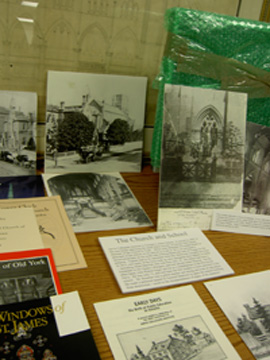 Cathedral. In recognition of Queen Elizabeth II’s Diamond Jubilee, the historical relationship between the monarchy and the city was featured. The evening began with a tour of the cathedral and refreshments. Nancy Mallett, Educator and Archivist for St. James Cathedral, spoke about the relationship between the Church (Toronto's oldest) and the Monarchy which includes visits and a Bible signing; and between the Church and the city of York, as the building served as the city’s first school and first hospital. She revealed holdings from Church archives that extend back to the 18th century. The extensive collection of photographs, documents and artifacts was open for the audience to view. This was followed by a talk via Skype from Coll Thrush, a history professor at UBC. "Indigenous Travellers and the English and British Monarchs, 1577-2006" examined the history of relationships between Indigenous Peoples and the Crown that ranged from exploitation to close alliances, which was followed by audience questions and discussion. Folders of resource materials were provided for teachers to use in their classrooms, including a booklet provided by the Lieutenant Governor's Office of Ontario titled 60 in/en 60 that was created to support a special exhibition celebrating the Queen's Diamond Jubilee.
Cathedral. In recognition of Queen Elizabeth II’s Diamond Jubilee, the historical relationship between the monarchy and the city was featured. The evening began with a tour of the cathedral and refreshments. Nancy Mallett, Educator and Archivist for St. James Cathedral, spoke about the relationship between the Church (Toronto's oldest) and the Monarchy which includes visits and a Bible signing; and between the Church and the city of York, as the building served as the city’s first school and first hospital. She revealed holdings from Church archives that extend back to the 18th century. The extensive collection of photographs, documents and artifacts was open for the audience to view. This was followed by a talk via Skype from Coll Thrush, a history professor at UBC. "Indigenous Travellers and the English and British Monarchs, 1577-2006" examined the history of relationships between Indigenous Peoples and the Crown that ranged from exploitation to close alliances, which was followed by audience questions and discussion. Folders of resource materials were provided for teachers to use in their classrooms, including a booklet provided by the Lieutenant Governor's Office of Ontario titled 60 in/en 60 that was created to support a special exhibition celebrating the Queen's Diamond Jubilee.
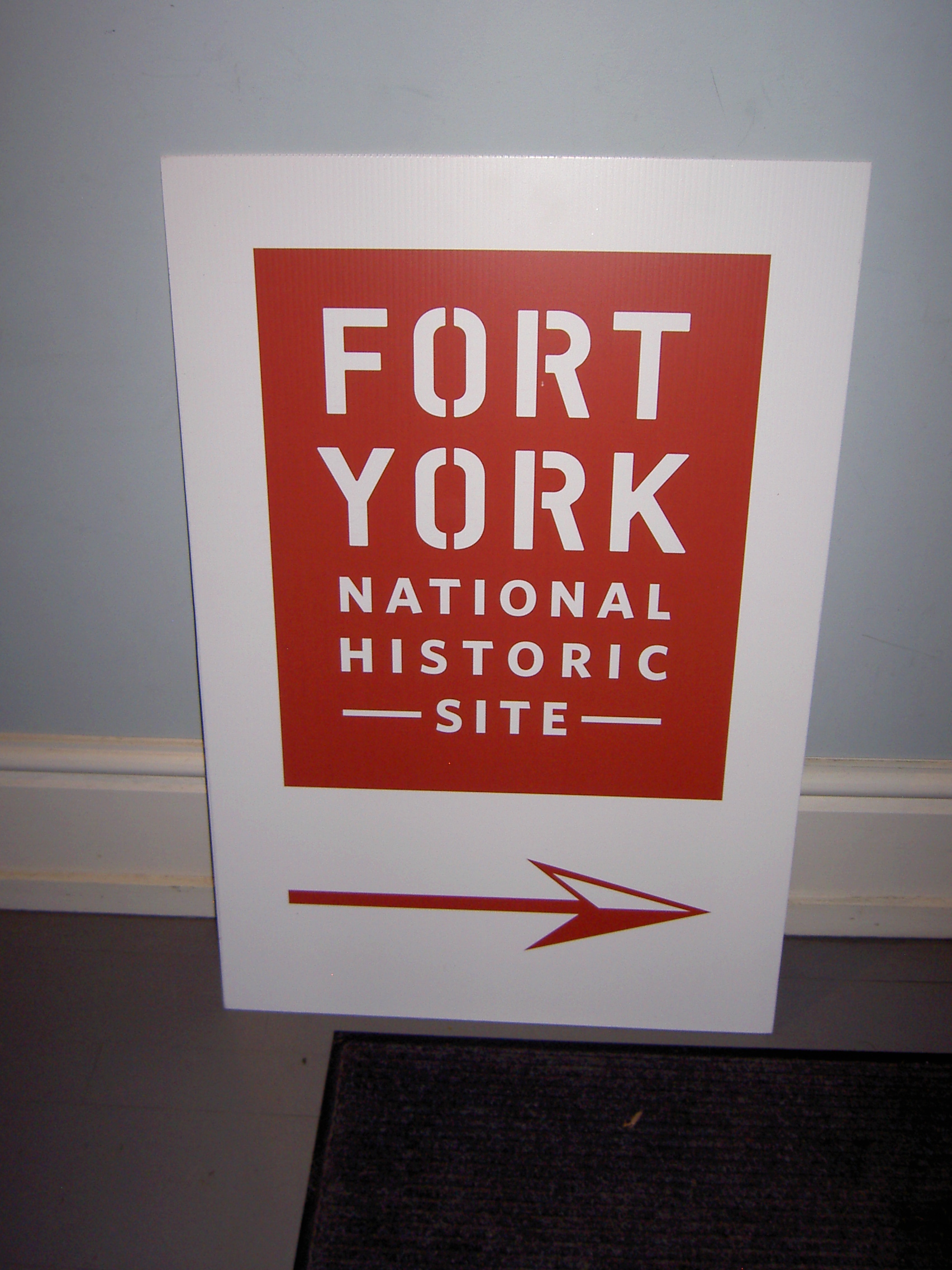 The second event, Life at the Fort, was held on December 4 at Fort York in Toronto. Richard Haynes, Museum Site Coordinator, provided an introduction and welcomed everyone to the fort. In honour of the War of 1812 and the bi-centennial of the City of Toronto, historian and curator Kelly Nesbitt spoke about fort life during this period, including the role of women and children. James Jenkins, Coordinator of the Walpole Island Community Cultural Centre and doctoral student at the University of Texas, spoke about the formation of Walpole Island in the aftermath of the War of 1812 and provided an important perspective of how Anishinaabe and other First Nations peoples experienced the war as well as the challenges of settlement during the period 1777-1815. A dialogue about what commemorations of the War of 1812 mean to various First Nations communities ensued. The purpose of the talks was to provide alternative narratives about the war to counter many historical accounts told in history classrooms, supply teachers and students with materials that will enhance their study of the period, and support the use of historical thinking concepts.
The second event, Life at the Fort, was held on December 4 at Fort York in Toronto. Richard Haynes, Museum Site Coordinator, provided an introduction and welcomed everyone to the fort. In honour of the War of 1812 and the bi-centennial of the City of Toronto, historian and curator Kelly Nesbitt spoke about fort life during this period, including the role of women and children. James Jenkins, Coordinator of the Walpole Island Community Cultural Centre and doctoral student at the University of Texas, spoke about the formation of Walpole Island in the aftermath of the War of 1812 and provided an important perspective of how Anishinaabe and other First Nations peoples experienced the war as well as the challenges of settlement during the period 1777-1815. A dialogue about what commemorations of the War of 1812 mean to various First Nations communities ensued. The purpose of the talks was to provide alternative narratives about the war to counter many historical accounts told in history classrooms, supply teachers and students with materials that will enhance their study of the period, and support the use of historical thinking concepts.
The third event for 2012/13 took place at Mackenzie House on February 27. Janet 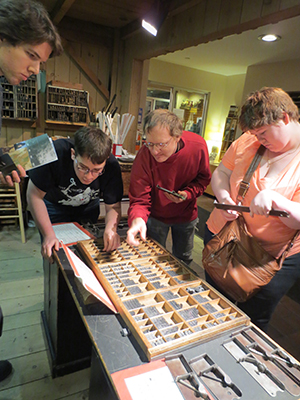 Schwartz, Museum Site Coordinator, talked about Mackenzie House programming and provided insight into the lives of William Lyon Mackenzie and his family, including his three daughters, his mother and his wife. Danielle Urquhart, Program Officer, provided a history of the printing press and newspapers from 19th century Upper Canada. Participants explored the printing press program and went home with a copy of Mackenzie’s newspaper, with their name on it, which they typeset themselves. Although Chris Raible was not able to attend due to a snowstorm, his handouts were included in the resource folders.
Schwartz, Museum Site Coordinator, talked about Mackenzie House programming and provided insight into the lives of William Lyon Mackenzie and his family, including his three daughters, his mother and his wife. Danielle Urquhart, Program Officer, provided a history of the printing press and newspapers from 19th century Upper Canada. Participants explored the printing press program and went home with a copy of Mackenzie’s newspaper, with their name on it, which they typeset themselves. Although Chris Raible was not able to attend due to a snowstorm, his handouts were included in the resource folders.
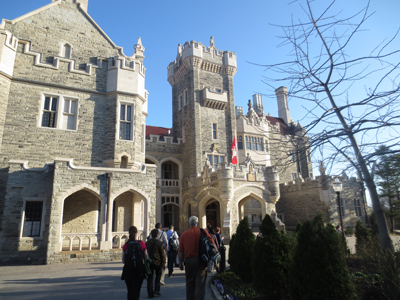 The fourth and final event of the season, Toronto: Multiple Voices, Multiple Lives, took place at the City of Toronto Archives, Casa Loma, and Spadina House on May 1. Archives staff demonstrated their Ward-based programming that focuses on how the area known as The Ward was represented visually over time. Sarah Bassnett, curator of the exhibit, spoke about the many lenses used to “picture” the Ward and explained how her exhibit was organized by various publications, including community-based newspapers, the Toronto Globe, and municipal photographs. The exhibit demonstrated how the images of immigrants were used in different ways. At Spadina House, led by Doug Fyfe, Program Officer, participants role-played particular interest groups to ask the wealthy Austin family for financial support. Mr. Fyfe also shared with us the story of the rise and fall of Sir Henry Pellat, Toronto entrepreneur and owner of Casa Loma.
The fourth and final event of the season, Toronto: Multiple Voices, Multiple Lives, took place at the City of Toronto Archives, Casa Loma, and Spadina House on May 1. Archives staff demonstrated their Ward-based programming that focuses on how the area known as The Ward was represented visually over time. Sarah Bassnett, curator of the exhibit, spoke about the many lenses used to “picture” the Ward and explained how her exhibit was organized by various publications, including community-based newspapers, the Toronto Globe, and municipal photographs. The exhibit demonstrated how the images of immigrants were used in different ways. At Spadina House, led by Doug Fyfe, Program Officer, participants role-played particular interest groups to ask the wealthy Austin family for financial support. Mr. Fyfe also shared with us the story of the rise and fall of Sir Henry Pellat, Toronto entrepreneur and owner of Casa Loma.
See the poster for more details.
Approaching the Past 2011/12
The first Approaching the Past event for 2011/2012, World War One and the Archives, held October 5, was a fantastic evening of history education focused on local narratives related to the First World War. The participatory program involved examining documents and researching the database at the Toronto Archives, and then engaging with documents that feature The Austins, a prominent Toronto family, at Spadina Museum Historic House. The visits and examination of documents at these two important sites helped history educators understand the ways in which the First World War impacted the citizens of Toronto.
The second Approaching the Past event, Secret Lives, Affective Learning: Using Drama to Teach History, was held on November 29 from 5 to 8 pm at the Zion Schoolhouse in north Toronto. Thirty-five graduate and teacher education students, faculty, and public history professionals attended. The event provided an opportunity for history educators to explore the past through historical theatre and included performances by three local theatre groups followed by discussion.
The third Approaching the Past event, Places and Their Stories: Recognizing the History Around Us, took place on March 7. Dr. Geoffrey Reaume and Jay Young, both from York University, connected history to places around Toronto, such as the historic wall around the Centre for Addiction and Mental Health, and Toronto Transit Commission stations such as Davisville and Eglinton West. Participants also were fortunate to get a tour of the historic Wychward Barns and learn about their history as a streetcar maintenance facility.
The fourth and final Approaching the Past event of the year, A Spring Walk: Historical Landscapes and Hauntings: Connecting Place to the History and Social Studies Curriculum, took place on May 9 at the University of Toronto. The event involved a spring walk around the campus. Although a rain storm scared away all but hearty participants, a good crowd braved the drizzle which in fact brought out the best of the natural environment and enhanced the stories about underground rivers and lakes by Lost Rivers speaker Helen Mills. Richard Fiennes-Clinton from Muddy York Walking Tours provided some insight on the kinds of walking trips that work well with history students and Rose Fine-Meyer spoke of using place-based education, examining local buildings and land, to support the Ontario Humanities and Canadian and World studies curriculum. The walk underscored pedagogical strategies for using experiential learning as a way to engage all learning types in the investigation of history.
Approaching the Past 2010/11
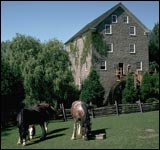 Approaching the Past kicked off its inaugural event at Black Creek Pioneer Village, Toronto, June 16. Professor Ruth Sandwell of OISE/UT was our guest speaker.
Approaching the Past kicked off its inaugural event at Black Creek Pioneer Village, Toronto, June 16. Professor Ruth Sandwell of OISE/UT was our guest speaker.
History is a Verb Activity
The second Approaching the Past event, The Past through Place, was held September 30 at Montgomery’s Inn Community Museum. Professor Julia Roberts led the workshop with a discussion of the ways that place—in this case, a historic tavern—can inform our understanding of the past and act as an entry point for teaching history. The themes discussed included issues of conflict, gender, and ethnicity in teaching the history of diverse times and places. Companion reading material for the workshop can be found in Jennifer Bonnell’s article, A Comforting Past: Skirting Conflict and Complexity at Montgomery’s Inn.
The third Approaching the Past event was held at Grenadier Cafe and Tea Room in High Park, January 27. Experiencing History was a workshop on teaching history through experiential education. Outdoor educator Bob Henderson led participants in activities and discussion focused on more physically active ways of teaching and learning history.
The fourth Approaching the Past event, Bridging the Gap Between History Student and History Teacher, was held on February 24. This workshop brought together faculty and students from York’s and OISE’s Faculties of Education to discuss making the transition from being a student of history to a teacher of history.
The fifth and final Approaching the Past event for the year was held on April 27.This workshop focused on teaching the War of 1812 and included discussion of teaching Aboriginal perspectives.

